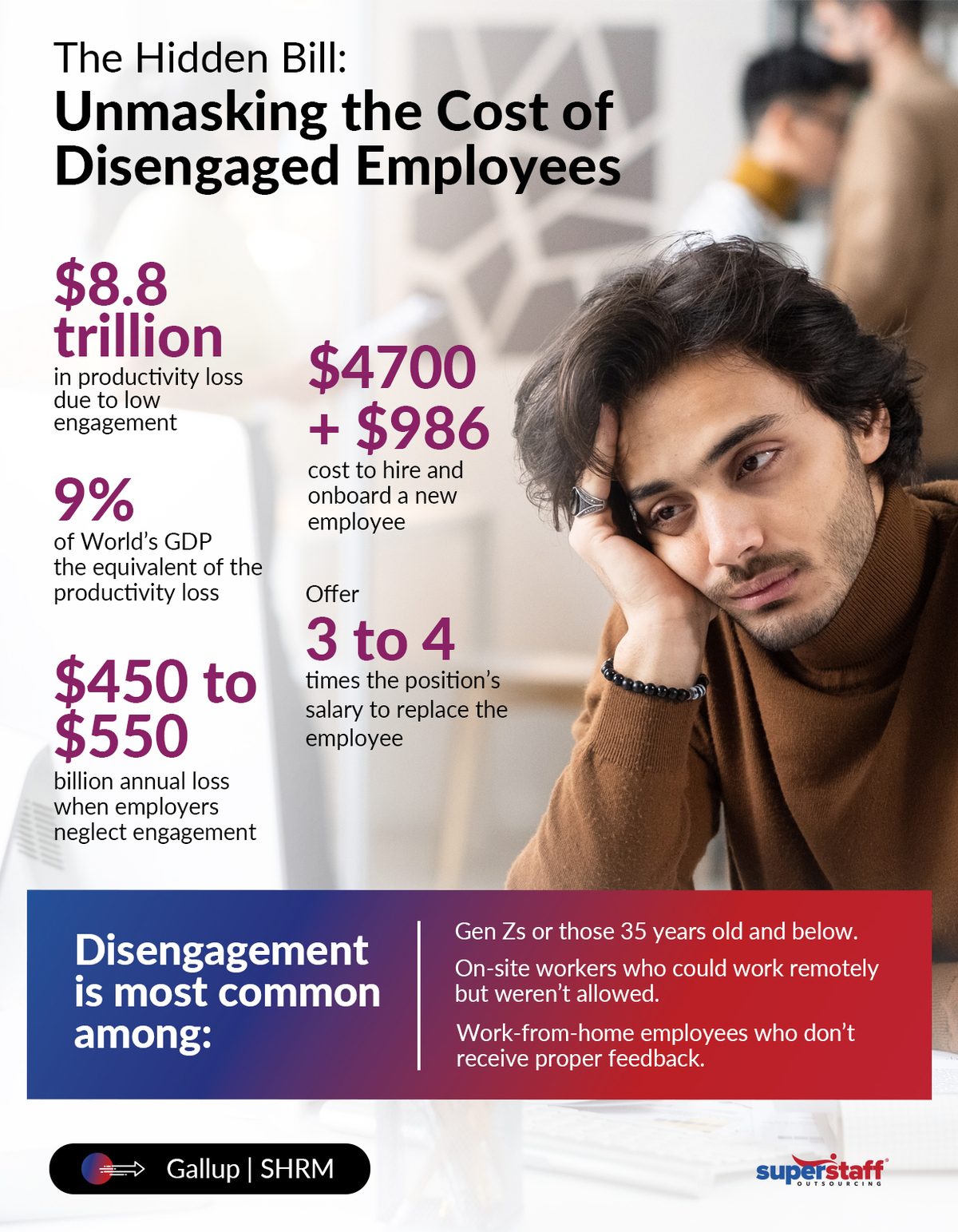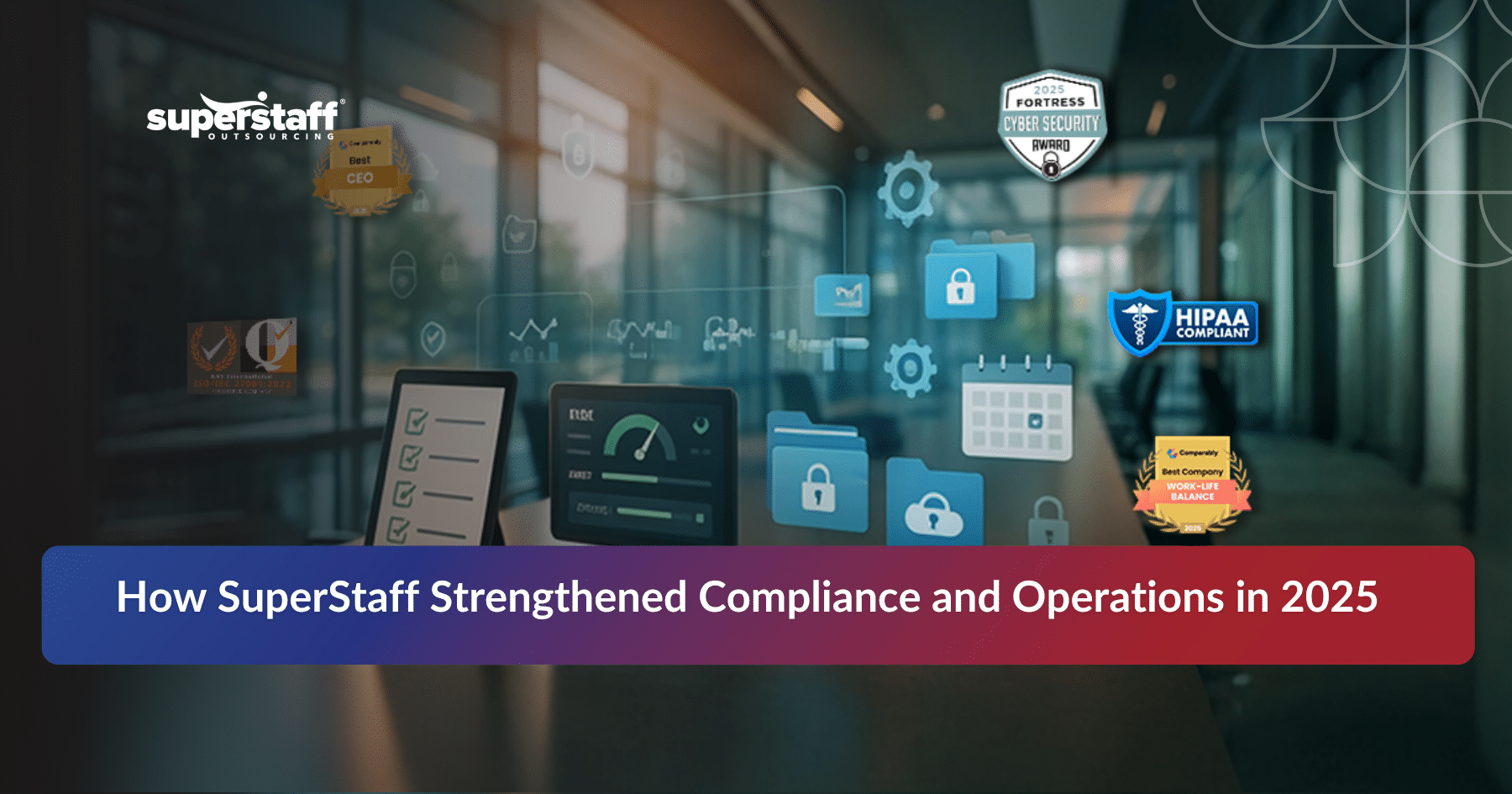
A happy and engaged workforce is often more productive than workers who are merely going through the motions. As such, businesses must pay close attention to and invest in employee engagement to keep their operations running smoothly.
The sad news is that today’s workers may not feel as connected to their workplace as they used to. Let’s explore the latest data and statistics, and then we’ll share practical tips on how to improve employee engagement, according to industry experts.
The Numbers Are In: Employees Don’t Feel Connected and Engaged at Work
According to a 2024 Gallup report, only 30% of employees feel engaged in their work, representing a decline of 4.8 million compared to the previous year. The researchers noted this is the lowest reported engagement level in over 11 years.
To make matters worse, 17% say they were actively disengaged in their workplace. In previous years, the U.S. has a ratio of 2.1 engaged employees for every disengaged worker. Now, that ratio has narrowed to 1.8-to-1, showing a steep decrease in overall employee engagement across the country.
The research found that the recent drops in engagement have been more pronounced among younger employees (particularly Gen Zs, down six points), exclusively onsite workers (down six points), and solely work-from-home employees (down five points).
What Is Employee Engagement?

Employee engagement refers to how involved and enthusiastic workers are about their jobs and workplace. It is a critical metric because it allows you to measure how your employees truly feel about elements of your work culture through an employee engagement survey and find ways to improve them.
Investing in employee engagement helps reduce staff turnover, enhances productivity, affects the company’s bottom line, and creates a better working environment for everyone.
Why Employee Engagement Matters in Powerful Statistics
According to Gallup’s “The Relationship Between Engagement at Work and Organizational Outcomes” meta-analysis, employee engagement has a substantial impact on the following aspects of business:
Greater Productivity
The assumption is true: Engaged employees are more productive. Gallup’s study found an 18% increase in productivity and an 81% decrease in absenteeism among workers whose employers prioritized engagement.
When people feel connected to their co-workers and workplace, they become more motivated to work hard. They will perform their tasks more efficiently and diligently because they care about doing well for themselves, their team, and the organization as a whole.
Lower Employee Turnover
It goes without saying that a highly engaged employee is a loyal employee. If your workers feel connected to your workplace, they are more likely to stay instead of searching for new job opportunities.
The same Gallup research highlighted that businesses focusing on employee engagement experienced an 18% decrease in attrition, even among high-turnover industries.
Enhanced Workplace Safety
Employee engagement also affects the frequency of safety issues in the workplace. Companies focused on engagement experienced 64% fewer accidents, 58% fewer patient safety incidents, and 28% less theft.
These numbers highlight that a more engaged workforce is likelier to be vigilant and less likely to make mistakes. So, if you notice recurring errors and problems in your workplace, prioritizing engagement may help address the issue.
Higher Product and Service Quality
The same Gallup research found that investing in employee engagement can affect product and service quality, leading to a 41% decrease in product defects and errors. Meanwhile, better service improves customer satisfaction by 10%.
What does this mean? In simple terms, employee engagement has a direct effect on your customers.
By caring for your workers, you encourage them to create better products and provide better services. They will then care for your buyers, helping provide a positive and memorable customer experience.
Increased Profitability
Finally, organizations prioritizing employee engagement enhance their bottom line, resulting in a 23% uptick in profitability. This number highlights how employee engagement is not just crucial for worker well-being but also has significant and tangible effects on a company’s bottom line.
A different study echoes these findings, showing that businesses prioritizing company culture reaped a massive 682% increase in revenue, a 901% increase in stock price, and a 756% uptick in net income.
Doing the Math: How Much Are Disengaged Employees Costing You?

Now that we’ve established the benefits of prioritizing employee engagement, we must discuss what will happen if you neglect this crucial workplace metric. What do you have to lose by overlooking worker satisfaction? Here’s what the numbers say:
Trillions in Productivity Losses
In Gallup’s 2023 State of the Global Workplace Report, industry experts estimated that low employee engagement costs businesses $8.8 trillion in productivity losses – roughly 9% of the world’s GDP!
Billions in Annual Revenue Lost
A different study found that companies lose about $450 to $550 billion annually due to neglecting employee engagement. Workers who are actively disengaged are more likely to perform poorly at work, leading to worse product or service quality and lower profitability.
Thousands in Additional Recruitment Costs
Since disengaged workers are more likely to quit their jobs, companies must also spend extra resources on starting the hiring process all over again. The Society for Human Resource Management (SHRM) estimated that it costs companies an average of $4,700 to hire a new employee and around $986 to onboard them.
However, depending on the specialized nature of the role, some businesses may have to spend 3 to 4 times the position’s salary just to find the right candidate. So, for instance, a job that pays $60,000 monthly may cost the company $180,000 to fill.
What the Experts Say: Practical Employee Engagement Strategies You Should Follow
Many employers assume that improving employee engagement is as simple as adding a ping-pong table to the office or having pizza on Fridays. However, actual change starts with evaluating your workplace culture, understanding what you’re doing right, and identifying ways to improve.
According to Gallup’s Q12 survey, the key elements influencing employee engagement include how employees feel about their contributions, whether they are recognized for their efforts, and whether they have space to grow. Knowing this, here are the best practices you should follow:
Make sure employees understand their roles and responsibilities.
The first item on Gallup’s employee engagement survey is “I know what is expected of me at work.” Many employers make the mistake of assuming that all workers already implicitly understand their expectations.
Remember: your employees are not mind readers. As a business leader, you’re used to seeing the bigger picture, but your workers only see puzzle pieces. It’s your job to ensure that all the pieces fit together and everyone works toward a common goal.
One research study found that role clarification significantly and positively impacts employee engagement, leading to higher job satisfaction and lower turnover rates.
To do this, you must set clear expectations about an employee’s role and responsibilities as early as the hiring stage. Any misunderstanding about a worker’s role in your organization can lead to frustration on both sides and may especially cause the employee to feel less connected to your organization, resulting in lower engagement and satisfaction.
Provide ‘meaningful’ feedback.
Employees appreciate meaningful feedback from their direct supervisors, whether they feel they are doing well or poorly. It lets them know that their efforts are recognized and that someone cares about their progress. This issue is crucial for younger workers like millennials and Gen Zs.
Here’s the problem: Only 19% of millennials say they receive routine feedback in the workplace, and even fewer (17%) receive what they consider “meaningful” critiques. Younger workers want to improve, learn, and grow, but only 14% say feedback from their performance reviews inspires them to do better.
Knowing this, how can employers provide “meaningful” feedback? The answer is to get to know their employees and welcome two-way conversations with them.
Gallup’s research highlights that employees who meet with their managers at least once a week have the highest level of engagement. Make time to converse with your workers regularly.
During these conversations, show a genuine interest in them, their aspirations, goals, and progress. Then, tailor your feedback depending on these individual ambitions. Are there ways you can help them move closer to their goals? What areas should they improve to achieve a particular task or role? What skills should they learn?
Recognize and reward good performance.
Another item in Gallup’s survey is “I have received recognition or praise for doing good work,” highlighting the importance of being rewarded for your efforts and performance. Employees are more likely to feel engaged and connected to their workplace when they feel that their excellent work is seen and appreciated.
According to a recent study, 61% of U.S. employees say they do not receive regular appreciation for their efforts, and 23% admitted they feel unappreciated at work. Not receiving praise or even recognition can cause workers to feel demotivated, leading to less engagement in the workplace.
One good strategy to address this issue is to provide top performers with awards or incentives. Supervisors and managers can also build trust and loyalty with their staff by conducting regular performance reviews, guiding and mentoring employees, and recognizing their great work, even individually.
Encourage personal and career development.
The last item on Gallup’s survey is “I have had opportunities at work to learn and grow.” Highly engaged employees feel that their company cares about their development and provides ways for them to advance their careers.
To achieve this, businesses must invest in employee training, upskilling, and mentorship opportunities. Effective managers get to know their workers individually, help them find their unique value, and work with them to align their natural talents with the organization’s goals.
However, taking an interest in your employees’ careers should not be where you stop. People also want to feel that their company cares about their personal growth, fulfillment, and well-being.
The American Psychological Association’s 2023 research found that 92% of employees want to work for an organization that values their emotional and mental health. Workers say they expect the following from their employers: employee mental health support (92%), respect at work (95%), and work-life boundaries (95%).
Measure employee engagement metrics regularly.
Although the three strategies mentioned above are tried-and-true best practices for improving employee engagement, business leaders know that there isn’t a one-size-fits-all solution for every organization.
The best way to measure engagement in your company is to ask for feedback directly from your employees through regular surveys.
You can use a combination of metrics to assess how many of your workers are actively engaged but also leave room for individual responses. Give everyone a chance to voice their opinions and concerns about how you can improve your work culture.
Take continuous action on employee feedback.
Finally, sending out surveys and reading the responses won’t improve employee engagement unless you find ways to address their concerns. Note that this step is not a one-and-done action but a continuous process.
You can send survey forms every few months and then check whether your employees’ feelings have shifted after you’ve made improvements based on their feedback. The truth is there will always be something that can be changed or enhanced, but the important thing is for your employees to feel heard and for them to know that you care enough to act on their concerns.
Did you enjoy reading about employee engagement? Follow SuperStaff for more relevant content!
As a people-centered BPO company, SuperStaff is committed to keeping up with employee engagement trends, data, and statistics. And we want to help businesses like yours stay updated as well!
You can follow us on Facebook and LinkedIn or browse our website for more helpful content on the latest workplace and business trends.






